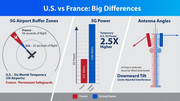Europe Has 5G. Here Is Why It Hasn’t Messed Up the Airlines.
https://www.barrons.com/articles/5g-eur ... 1641398766
Meanwhile, across the Atlantic, Europe has 5G and air travel and cargo shipments continue safely. It hasn’t wreaked the havoc Airlines for America warned about.
Why the difference? There could be a number of factors at play, experts told Barron’s.
One thing is for sure: a green light for 5G in Europe doesn’t come from a lack of caution among regulators. After all, the European Union Aviation Safety Agency (EASA) last month warned about the potential risk of interference from 5G near airports—in the U.S.
The EASA said at the time that “no risk of unsafe interference has been identified in Europe.” Instead, the regulator cited the Federal Aviation Administration, which saw specific risk in the U.S. due to the implementation of potentially higher 5G ground station power emissions early this year.
The source of more wariness in the U.S. may stem from the guts of the radio technology itself.
The issue at hand is whether signals from 5G radio bands—intended for devices—could interfere with aircraft altimeters, which are crucial instruments that tell pilots the altitude of their plane. Radar altimeters are close neighbors to 5G in the radio spectrum.
This potential problem is most pronounced upon landing when 5G stations on the ground are emitting close to an altimeter, or 5G smartphones are transmitting within the plane. This explains why regulators are focused on the safety impact around airports.
George Holmes, the chair and CEO of Resonant (RESN) a 5G industry player, told Barron’s that the difference between the U.S. and Europe stems from allocated frequencies for 5G, and their proximity to the defined band for altimeters.
Resonant is a Nasdaq-listed company that designs radio frequency filters, which are used to isolate signals from the right band while blocking unwanted noise from elsewhere in the radio spectrum. These filters are critical in 5G applications.
In the U.S., 5G is allocated to a range of between 3.7GHz and 3.98GHZ, which is closer to the 4.2GHz-4.4GHz frequency for altimeters than in Europe, which has allocated the 3.4GHz-3.8GHz range for 5G. Holmes said that in Europe altimeter filters will be better at stopping 5G signals, which will result in less potential interference.
“We are dealing with very low probabilities but extremely devastating consequences,” Holmes said. “We are still in the early stages of 5G deployments and usage, so this interference problem remains a potential for the future.”
5G interference could cause Boeing 787s to run off the runway, the US’ FAA warns
https://www.euronews.com/next/2022/01/1 ... -faa-warns
In a notification to airlines, the FAA said that Boeing 787s operated by over 80 international airlines including Air France, British Airways, KLM, LOT, and holiday operator TUI could be affected by interference when landing at airports in the United States.
Why is 5G different?
The issue the FAA is talking about relates to the part of the wireless frequency spectrum given over to 5G, particularly in the US.
Most countries around the world have dedicated a portion of the C-Band radio frequency to 5G. In Europe, this falls in the 3.3-3.8 GHz segment of the wireless spectrum, but in the US, the 5G network due to be switched on this week will operate at 3.7-3.9 GHz.
The radio altimeters in aircraft operate at a frequency of 4.2-4.4 GHz, bringing the 5G signal uncomfortably close, as far as the air safety regulator is concerned.
European regulators have also voiced worries about 5G interference, leading some countries to act.
France's aviation safety authority, the DGAC, issued a notice in February last year stating that altimeter errors could have a "significant adverse impact on flight safety" and recommending that 5G-enabled devices should not be used inflight.
The FAA has also taken a leaf out of France's book, putting buffer zones in place around 50 major airports where mobile network operators will have to turn off 5G towers or work to limit their potential to interfere with aircraft.
This buffer zone will be wide enough to cover the final 20 seconds of flight before landing, the FAA said. That compares to the 96-second buffer zone in force in France, where 5G antennas are also angled downwards in order to reduce the risk of interference.

In four years, you don’t have to vote again. We’ll have it fixed so good, you’re not gonna have to vote.


